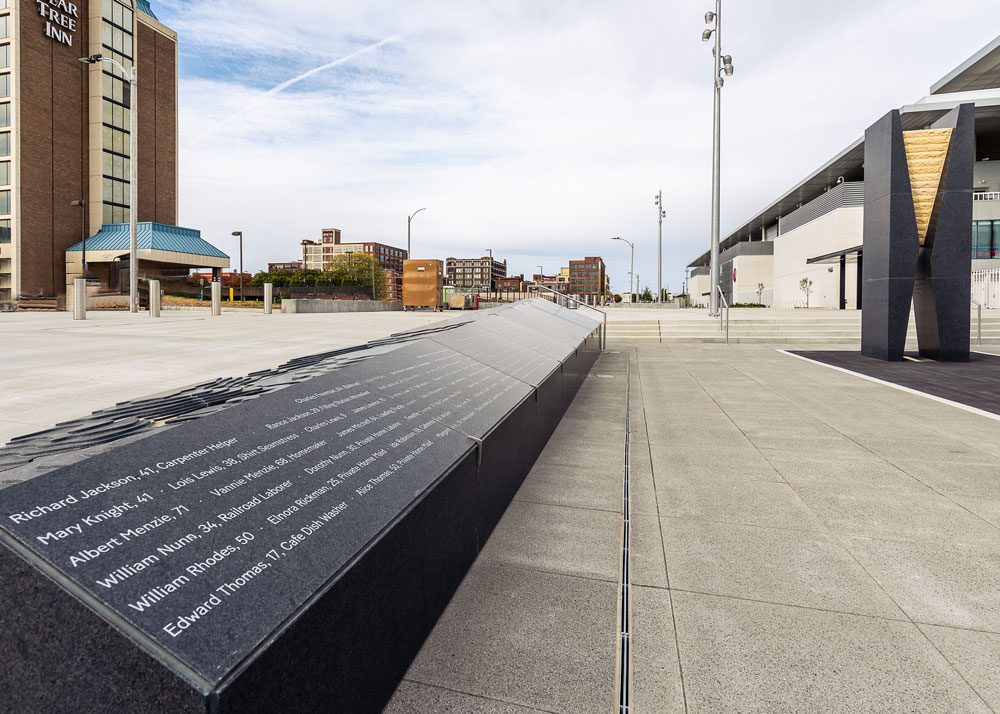Great Rivers Greenway
Great Rivers Greenway
Damon Davis
Lamar Johnson Collaborative
Leonard Masonry
Rhodey Construction
Larson Engineering, Inc.
During the 20th century, the Mill Creek Valley neighborhood in central St. Louis was one of the largest and most vibrant African American communities in the United States. The neighborhood’s 450 acres were home to more than 20,000 residents, 800 businesses and 40 houses of worship, renowned as a center for art, music, nightlife, religion and social activism.
By the 1950s, redlining and segregation practices that were common at the time began to take their toll on the neighborhood’s condition and living standards. City officials approved the destruction of the entire Mill Creek Valley neighborhood in 1959, citing “urban renewal” as the reason behind the decision. All residents were displaced from their homes and numerous historically significant buildings were demolished.
 Damon Davis, a St. Louis resident and nationally acclaimed artist, began work on the Pillars of the Valley monument in 2021. Completed in 2022, the public art installation pays tribute to the people of Mill Creek Valley, helping to ensure their stories, contributions and cultural legacy remain part of the public conversation as progress continues to be made.
Damon Davis, a St. Louis resident and nationally acclaimed artist, began work on the Pillars of the Valley monument in 2021. Completed in 2022, the public art installation pays tribute to the people of Mill Creek Valley, helping to ensure their stories, contributions and cultural legacy remain part of the public conversation as progress continues to be made.
The monument stands in the plaza next to the new St. Louis City SC MLS soccer stadium — both are located where the Mill Creek Valley neighborhood once stood — and is part of the larger Brickline Greenway revitalization project. Informed by four years of community engagement and spearheaded by a regional public agency, the project will ultimately connect several neighborhoods and attractions throughout the city with 20 miles of pedestrian-friendly pathways and green spaces.
Pillars of the Valley is anchored by eight identical, 15’ x 4’-0” x 4’-0” hourglass-shaped pedestals fabricated from Coldspring Mesabi Black® granite, with each pedestal holding a textured V-shaped limestone piece representing hourglass sand. Sand is made from soil — and much like soil, the stories of former Mill Creek Valley residents can be excavated and placed on a similar pedestal for the world to see and remember. Quotations from neighborhood residents are captured on pedestal panels.


Along one edge of the installation is a 42’-7’-long horizontal plinth, also fabricated from Mesabi Black granite, that displays a list of resident names and map on one side, along with a dimensional topographical depiction of the Mill Creek Valley Neighborhood along the Mississippi River on the other side. A display panel on the opposite edge tells the story of the neighborhood and meaning of the art installation in both text and braille, set alongside a small-scale replica of the monument pieces in stainless steel with a gold finish.
Granite was specified for the Pillars of the Valley monument due to its stately appearance and symbol of permanence. The natural stone was also ideal for withstanding the harsh Midwestern elements. The deep black color helps enhance legibility for the gray text used throughout the installation, while creating a bold and eye-catching contrast to the soccer stadium and other lighter-colored elements nearby. A combination of honed and textured granite is incorporated throughout.
Team members from Rhodey Construction, the project contracting company headquartered in nearby Ferguson, Missouri, knew they needed to work with a domestic quarry in relatively close proximity to help meet an aggressive schedule. With its quarry in Babbitt, Minnesota, Coldspring stood apart as the best resource to go from initial drawings through final fabrication and installation within the required timeframe of six months. All other competitive bids estimated one year or longer.
Coldspring was also chosen for its proven capabilities in managing complex fabrication requirements — from the gradual sloping needed on each pedestal piece to the intricate CNC tooling needed to build each level of the contoured plinth. Coldspring also custom-engineered stainless steel dowel pieces to affix each V-shaped limestone piece to the pedestals.
Transporting the large, heavy sections of granite 775 miles posed yet another challenge. Each of the three sections per pedestal was more than 32 cubic feet in size and weighed more than 5,600 lbs. Mobile cranes with reinforced nylon straps were used to set each piece in place at the installation site.
Many historians believe that before real societal progress can be made, we must first take the time to examine, discuss and learn from the achievements and transgressions from our past. With the striking Pillars of the Valley monument now serving as a bold, beautiful reminder where a vibrant neighborhood once stood, hope has been renewed that the stories of the people of Mill Creek Valley will never be set aside or forgotten again.
To discover more about the kinds of creations Coldspring has made with our materials, reach out to us today.